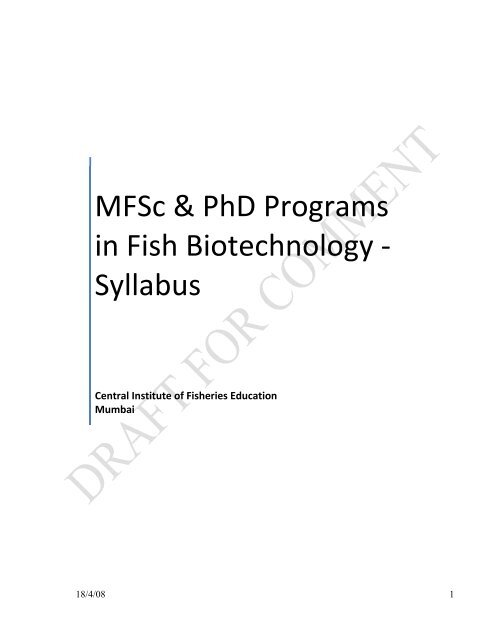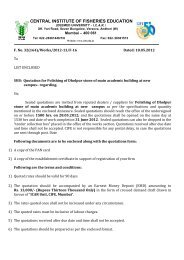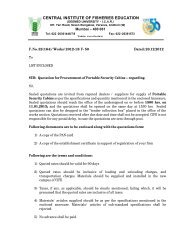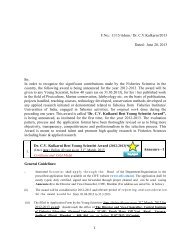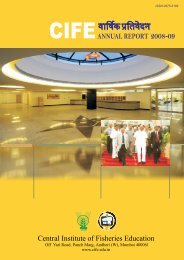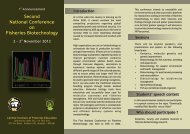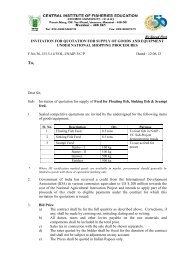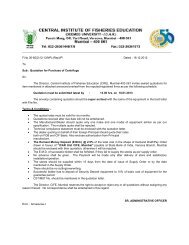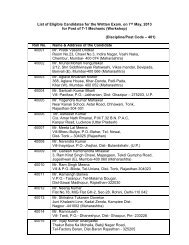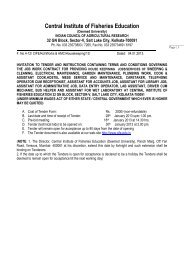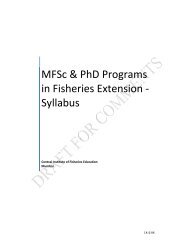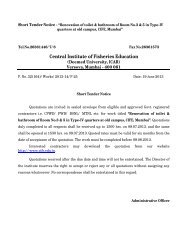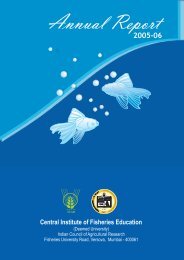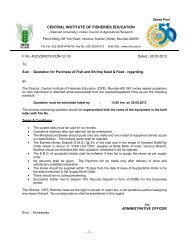Fish Biotechnology MFSc & PhD Syllabus.pdf - Central Institute of ...
Fish Biotechnology MFSc & PhD Syllabus.pdf - Central Institute of ...
Fish Biotechnology MFSc & PhD Syllabus.pdf - Central Institute of ...
Create successful ePaper yourself
Turn your PDF publications into a flip-book with our unique Google optimized e-Paper software.
<strong>MFSc</strong> & <strong>PhD</strong> Programsin <strong>Fish</strong> <strong>Biotechnology</strong> -<strong>Syllabus</strong><strong>Central</strong> <strong>Institute</strong> <strong>of</strong> <strong>Fish</strong>eries EducationMumbai18/4/08 1
M.F.Sc (<strong>Fish</strong> <strong>Biotechnology</strong>) - Major CoursesCode Course Title CreditsCORE COURSES1. FB 501Fundamentals <strong>of</strong> Molecular Biology 2+12. FB 502Basic concepts <strong>of</strong> Cell biology 2+13. FB 503Gene structure and expression2+14. FB 504 Genetic Engineering & its application in fisheries 2+1OPTIONAL COURSES1. FB 505Molecular and Immunogenetics1+12. FB 506Bioinforatics1+13. FB 507Cell culture and Hybridoma technology1+14. FB 508Marine biotechnology1+15. FB 509Aquaculture <strong>Biotechnology</strong>1+1<strong>PhD</strong> (<strong>Fish</strong> <strong>Biotechnology</strong>) - Major CoursesCode Course Title CreditsCORE COURSES1. FB 601Advances in Molecular and Cell Biology 2+12. FB 602Genetic Engineering <strong>of</strong> Eukaryotes 2+13. FB 603 Genetic Engineering <strong>of</strong> Bacteria and Viruses 2+1OPTIONAL COURSES1. FB 610Biosafety and Patent laws2+02. FB 611Functional Genomics and proteomics1+13. FB 612Protein Engineering1+118/4/08 2
Basic concepts <strong>of</strong> Cell biology 2+1Objective : To outline the basic structure growth and differerntiation <strong>of</strong> prokaryotic andeukaryotic cell, sub cellular componenets and their functionTheoryProkaryotic and eukaryotic cell architecture : Cell theory; diversity <strong>of</strong> cell size and shape;Organization and function <strong>of</strong> sub-cellular organelles – cell membrane; cytoplasm;endoplasmic reticulum; Golgi apparatus; lysosomes; mitochondria; nucleolus; peroxisomesand sub-nuclear structures;Principles <strong>of</strong> membrane transport: Active/passive membrane transport (Case study -Osmoregulation in freshwater and marine fishes) ion channels; carrier proteins; cellsignaling.Cell division : cell cycle and its regulation; Cell growth and differentiation;Cell motility : actin-myosin filaments; flagella; ciliaProtein sorting : secretion and targeting; vesicular traffic; endocytosis; exocytosis; proteintranslocation and secretary pathways.PracticalMicroscopic techniques- bright field, phase contrast and fluorescent microscopy;Microtomy; Sub-cellular fractionation and their functional integrity; Chromosomepreparation; Histochemical techniquesSuggested Reading1. Molecular Biology <strong>of</strong> Cell – Alberts B et al.2. Molecular cell biology – Lodish et al.3. Cell in development and inheritance – Wilson et al4. Developmental Biology – S.F GilbertJournal references18/4/08 4
Gene structure and regulation <strong>of</strong> expression 2+1Objective: To understand the structure <strong>of</strong> genes in prokaryotes and eukaryotes and thesignificance <strong>of</strong> cis and trans acting genetic elements in regulation <strong>of</strong> gene expression.TheoryGene structure : Promoters, UTRs, ORFs, exons, introns, termination signal, mono- andpolycistronic genes, Gene clustering; Overlapping genes in (Phi X174 virus)Bacteriophage genome : organization and life cycle <strong>of</strong> Lambda and M13;Regulation <strong>of</strong> gene expression in Prokaryotes : Operon concept (Lac/Trp); SOS response,bidirectional promoters.Regulation <strong>of</strong> gene expression in Eukaryotes : DNA protein interactions (zinc fingers,leucine zippers, helix turn helix, Z-DNA); transcription factors, promoters, enhancers,repressors, insulators, attenuators, IRES, alternative splicing.RNA in gene regulation : antisense RNA, microRNA, ribozymes.Case study : Molecular regulation <strong>of</strong> growth hormone expression in carp/or Molecularregulation <strong>of</strong> Na+K+ ATPase in gills and kidney cells <strong>of</strong> freshwater and marine fishes.Expression analysis – Techniques to test the up and down regulation <strong>of</strong> specific genes likeMicro array and Real time PCR.Epigenetics - DNA methylation, genetic imprinting, histone modifications, chromatinremodeling.Inhibitors <strong>of</strong> transcription and translation : mode <strong>of</strong> function and resistance mechanism –Actinomycin D, α – amanitin, Rifampicin, Tetracyclin, Streptomycin, Chloramphenicol,kanamycin, Cyclohaxamide, Diptheria toxin, Ricin.Site-directed mutagenesis and its applicationsPracticalExpression studies <strong>of</strong> a gene controlled by lacz promoter – Induction, blue/white selection,cell extract separation by PAGE and western blotting; lambda plaque formation on E. colilawn; Seperation <strong>of</strong> gill extract on PAGE and histochemical staining <strong>of</strong> Na+ K+ ATPase <strong>of</strong>fish kept at different salinities; retrieval <strong>of</strong> gene information from ensemble and NCBI,BLAST.Suggested Reading18/4/08 5
1) Gene IX – Benjamin Lewin.2) Concepts in biochemistry – Rodney BoyerJournal referencesGenetic Engineering and its application in fisheries 2+1Objective: To detail the basic steps in recombinant DNA technology and its application inoptimization <strong>of</strong> production, health and environment in fisheries.TheoryRecombinant DNA technology : DNA modifying enzymes - types <strong>of</strong> restrictionendonucleases (Type I, II and III), DNA/RNA modifying enzymes (alkaline phosphatases,kinases, exonucleases, ligases, terminal transferases); Vectors - plasmids (replication, copynumber control and compatibility), phagemids, cosmids, high capacity vectors (eg. BAC),shuttle vectors; Adapters, linkers, ligation, transformation and selection.Hosts: prokaryotic (selected E. coli strains) and eukaryotic (selected yeast strains).DNA amplification : PCR – principle, types and applications; T/A cloning <strong>of</strong> amplifiedproducts; Structure and function <strong>of</strong> DNA polymerase and reverse transcriptase.Genomic DNA library: construction, screening (PFGE) and applications; chromosomewalking.cDNA library: construction, screening (PFGE) and clone characterization;DNA and protein sequencing: principle, types and applicationsApplication <strong>of</strong> rDNA technology : transgenesis – fish as a model organism, target genes,methods <strong>of</strong> gene transfer, transgenic screening techniques; Production <strong>of</strong> diagnostics andvaccines; bi<strong>of</strong>actories, biosensors, waste water treatment, probiotics, GMOs - Biosafetyregulations and ethical issues related to biotechnological products; patent laws and IPRissues.Optimization <strong>of</strong> recombinant protein expression in prokaryotes and eukaryotes.Nucleic acid hybridization : Southern, Northern and Western blotting; DNA probes andtheir labeling.Practical18/4/08 6
Cloning strategies – insert and vector preparation, ligation, preparation <strong>of</strong> competent cells,transformation, clone confirmation techniques (horizontal slot lysis/colony PCR); Southernhybridization, probe Labeling methods; Primer designing; DNA sequencing and analysis.Suggested Reading1. Molecular Cloning: A laboratory Manual- J. Sambrook et al.2. Genomes – T.A. Brown3. Gene IX – Benjamin Lewin.Journal referencesMolecular and Immunogenetics 1+1Objective: To aquaint the students with techniques that are used to estimate geneticvariation among individuals and populations for various purposes and DNA diversitygenerated by somatic recombination <strong>of</strong> immunoglobulin genes.TheoryBiochemical markers: Allozyme polymorphism and its application in estimating populationgenetic parameters.Molecular markers: RAPD, RFLP, AFLP, EST, SNP, Minisatellites and Microsatellites andapplication in population genetic analysis and gene mapping, FISH – principle andapplication.Analysis: Interpretation <strong>of</strong> gels and data analysis using various s<strong>of</strong>twares. DNA sequencepolymorphism and related s<strong>of</strong>tware for alignment and analysis.Immunogenetics: Molecular biology <strong>of</strong> Ig synthesis, genetic basis <strong>of</strong> antibody diversity,humoral B-cell immunoglobulins, T-cell receptors and MHC.PracticalBiochemical markers: Allozyme polymorphism. Molecular Markers: RAPD, RFLP, AFLP,Minisatellites and Microsatellites.Interpretation <strong>of</strong> gels and data analysis.Suggested Readings:1. Pasteur et al 1988. Practical isozyme genetics. Ellis horwood ltd, England :215p2. Caetano-anolles G and Gressh<strong>of</strong>f P.M. 1998. DNA Markers: Protocols, Applicationsand overviews. Wiley-VCH, NY: 364p18/4/08 7
Suggested Reading1. Bioinformatics Basics : Applications in Biological Sciences and Medicine –Rashidi,H.H and L.K. Buehler2. Introduction to Bioinformatics – Attwood, T.K. and D.J. Parry- Smith3. Bioinformatics : Sequence and Genome Analysis, David W. Mount.4. Bioinformatics: A biologists guide to biocomputing and the internet – Stuart M.BrownJournal referencesCell culture and Hybridoma technology 1+1Objective: To introduce students to basic cell and tissuie culture techniques and theirapplications in health management, gene banking and genetic characterizationTheoryIntroduction: Structure and Organization <strong>of</strong> animal cell; Equipments and materials foranimal cell culture technology.Cell lines and media: Primary and established cell line cultures; media supplements – theirmetabolic functions; serum & protein free defined media and their application.Cell culture: Basic techniques <strong>of</strong> cell culture in vitro; development <strong>of</strong> primary cultures, cellseparation, maintenance <strong>of</strong> cell lines; biology <strong>of</strong> cultured cells, transformation anddifferentiation <strong>of</strong> cell cultures.Characterization <strong>of</strong> cell lines : measurement <strong>of</strong> viability and cytotoxicity assays; measuringparameters <strong>of</strong> growth; karyotyping, isozyme assays, cryopreservation, assessment <strong>of</strong>contaminants,Cell cloning and micromanipulation; cell transformation; application <strong>of</strong> fish cell culture;scaling-up <strong>of</strong> cell culture.Stem cells: Stem cell cultures, embryonic stem cells and their applications; cell culture basedvaccines, organ and histotypic cultures; measurement <strong>of</strong> cell death; apoptosis; threedimensional culture and tissue engineering.Cell Hybridization: Somatic cell fusion, hybridoma technology, Production and Application<strong>of</strong> monoclonal antibodies.Practicals18/4/08 9
Preparation <strong>of</strong> cell culture medium and membrane filtration, preparation <strong>of</strong> single cellsuspension from spleen and thymus, cell counting and cell viability; macrophagemonolayer from PEC and measurement <strong>of</strong> pathogenicity activity, trypsinization and subculturing, cryopreservation and thawing; measurement <strong>of</strong> doubling time, preparation <strong>of</strong>metaphase chromosome spread from cultured cells, isolation and demonstration <strong>of</strong>apoptosis <strong>of</strong> DNA laddering, cell fusion with PEG, monoclonal antibody production,transfection techniques.Suggested Readings1. Culture <strong>of</strong> Animal Cells,(3rd Edition),R.lan Froshney,Wiley-Liss.2. Animal Cell Culture-Practical Approach,Ed.john R.W.Mesters,Oxford.3. Cell Growth and Division:A Practical Approach,Ed,R.Basega,IRL Press.4. Cell Culture Lab Fax.Eds.M.Butler & M.Dawson,Bios Scientific PublicationsLtd.Oxford.5. Animal Cell Culture Techniques.Ed.Martin Clynes,Springer.6. Methods in Cell Biology, Vol.57,Animal Cell Culture Methods.Ed.Jenni P Mathurand David Barnes.Academic Press.Journal referencesMARINE BIOTECHNOLOGY (1+1)Objective: To give the students an overview on the potential marine resources for bioactivecompounds, pharmaceuticals and the application <strong>of</strong> biotechnological tools to combatmarine pollution.Introduction: Historical background, overview <strong>of</strong> the present status <strong>of</strong> marinebiotechnology, commercially important and potential species, micro-algae, macro-algae,aquaculture.Marine Resources: biodiversity, marine natural products, valuable chemicals, biomedicaland bioactive compounds from marine organisms, commercial bio-products from marineorganisms; green fluorescent protein from jelly fish and its application, marine organisms asa source <strong>of</strong> polysaccharides, antiviral, anticancer and anti-inflammatory compounds; andcommercially important enzymes - Xylanase, agarase, proteases, chitinases, amylase,lipases, cellulase, phytase.Environmental <strong>Biotechnology</strong>: marine biotechnology for economic development andenvironmental problem solving, bio-film and bio-remediation, bio-sensor and transgenicmarine organisms; unculturable bacteria- occurrence, characteristics, characterization andexploitation; metagenomic library <strong>of</strong> unculturable bacteria, marine pollution and its18/4/08 10
control; genetically engineered microbes for waste water treatment; Red sea tide and itscontrol, bi<strong>of</strong>ouling and prevention.Gene mining : Identification <strong>of</strong> genes responsible for novel proteins, rDNA technology forthe large scale production <strong>of</strong> novel proteins, pharmaceutical, cosmetic and neutraceuticalsand their use in drug designing - for various finfish and shellfish bacterial and fungaltoxins.Fermentation technology : types – batch, continuous; Down stream processing <strong>of</strong>commercially important compounds.PracticalsExtraction <strong>of</strong> bioactive compounds from seaweeds, microalgae, sponges and test theirefficiency microbiology, biochemistry and molecular assays, isolation <strong>of</strong> marine algae,plankton and its culture method, methods for isolation <strong>of</strong> viable and unculturable bacteriafrom sea, recombinant DNA technology to produce commercially important enzymes.SUGGESTED READINGS:1. Drugs from sea (2000) Fusetani, N.2. Microbiology <strong>of</strong> deep sea hydrothermal vents (1995) Karl, D.M.3. The search from bioactive compounds from microorganisms (1992) Omum,4. <strong>Biotechnology</strong> and Biodegradation (1990). Kamely, D. Chakraborty, A. & Omenn, G.S.5. Recent Advances in Marine <strong>Biotechnology</strong>. Vol.2 (1998) Fingerman, M., Nagabushanam,R., Thompson, M.6. <strong>Biotechnology</strong> in the marine sciences: Proceedings <strong>of</strong> the first annual MIT sea grantlecture & seminar. (1984). Colwell, R.D.(Ed)Aquaculture <strong>Biotechnology</strong> 1+1Objective: To provide an overview <strong>of</strong> the application <strong>of</strong> biotechnological tools in fishbreeding, feed, health, processing and other issues in fisheries.Theory<strong>Fish</strong> Breeding: Synthetic hormones for induced breeding- GnRH analogue structure andfunction.18/4/08 11
Transgenesis : Methods <strong>of</strong> gene transfer in fishes, single gene traits, screening fortransgenics, site <strong>of</strong> integration, applications, regulation <strong>of</strong> GMOs, IPR, Evaluation <strong>of</strong> GFPtransgenics.Gene Bank and conservation: Cryopreservation <strong>of</strong> gametes and embryos.Feed Technology: Micro encapsulated feeds, micro coated feeds, micro-particulate feedsand bio-encapsulated feeds, mycotoxins and their effects on feeds.Health Management: DNA and RNA vaccines, molecular diagnosis <strong>of</strong> viral diseases, PCR,Dot-blot, ribotyping <strong>of</strong> pathogenic microbes, RNAi, Bi<strong>of</strong>ilms and its impact on healthmanagement, genetically modified micro-organisms as probiotics, immunostimulants,bioremediation <strong>of</strong> soil and water.Algal <strong>Biotechnology</strong>: Microalgae - indoor and mass culture methods, biotechnologicalapproaches for production <strong>of</strong> important microalgae, single cell protein from Spirulina,raceway system <strong>of</strong> micro algae culture, vitamins, minerals and omega3 fatty acids frommicro algae, enrichment <strong>of</strong> micro algae with micronutrients.Post harvest biotechnology: Delaying <strong>of</strong> spoilage, detection <strong>of</strong> toxic substances andpathogenic microbes, biosensors for toxins.Application <strong>of</strong> nanotechnology in aquaculture.PracticalsInduced breeding <strong>of</strong> carps, spirulina culture, identification <strong>of</strong> selected algae,cryopreservation <strong>of</strong> gametes, diagnosis <strong>of</strong> WSSV, micro-encapsulation, ribotyping, HAACPmethods, preparation <strong>of</strong> agar, PCR amplification and cloning <strong>of</strong> growth hormone gene,transgenesis, chromosomal manipulation- androgenesis, gynogenesis, triploidy, tetraploidy.Suggested Readings:1. <strong>Fish</strong> Genetics and <strong>Biotechnology</strong> – Ayappan et al . ICAR publication2. <strong>Fish</strong>eries <strong>Biotechnology</strong> – W.S. LakraJournal references18/4/08 12
<strong>PhD</strong> MAJOR COURSESAdvances in Molecular and Cell Biology 2+1Objective: To provide a deeper understanding <strong>of</strong> the molecular and cellular processesinvolved in the functioning, maintenance and death <strong>of</strong> living cells.TheoryContent <strong>of</strong> the genome : genome size and complexity, C-value paradox, repetitive and nonrepetitiveDNA, Cot curve, evolution <strong>of</strong> interrupted genes, cluster and repeats, genefamilies, pseudogenes, evolutionary clock.Protein localization and trafficking : Co-translational and post-translational translocation,post-translational modifications; Protein transport through ER - Golgi system; Anterogradeand retrograde transport; Exo- and endocytosis; Clathrin coated vesicles; membrane fusionand protein localization; Ubiquitin pathway for protein degradation;Signal transduction: active and passive transport, carrier proteins (uniporter/symporter/antiporter), ion channels (ligand and voltage gated channels), G-proteins,signaling pathways (Ras/MAPK, JAK-STAT)Cell cycle and growth regulation: cell cycle check points, cyclins, CDKs (Cycline dependentkinases); Cell differentiation; Apoptosis: programmed cell death – genetic pathways forPCD, anti and proapoptotic proteins.Epigenetics : DNA imprinting, histone modifications, histone code.Oncogenes and tumour suppressor genes: Viral and cellular oncogenes, tumour suppressorgenes; Structure, function and mechanism <strong>of</strong> action <strong>of</strong> pRB and p53 tumour suppressorproteins;RNA interference : History, molecular mechanisms and applications <strong>of</strong> antisense RNA,microRNA, siRNA and Ribozymes;PracticalsDNA sequence analysis for identification <strong>of</strong> cis acting elements – kozak sequence, intronexonboundaries, poly A signal, terminators, promoters, transcription factor binding sites,zinc finger motif, cellular localization signals using bioinformatics s<strong>of</strong>twares availableonline; multiple alignment, tandem repeat identification, promoter analysis,antisense/siRNA design.18/4/08 13
Suggested Reading1. Molecular Biology <strong>of</strong> Cell – Alberts B et al.2. Molecular cell biology – Lodish et al.3. Cell in development and inheritance – Wilson et al4. Developmental Biology – S.F Gilbert5. Gene IX – Benjamin Lewin.6. Concepts in biochemistry – Rodney BoyerJournal referencesGenetic Engineering <strong>of</strong> Eukaryotes 2+1Objective: To provide indepth knowledge on the techniques available for the geneticengineering <strong>of</strong> eukaryotes and strategies to optimize recombinant protein production ineukaryotic expression systems.TheoryEukaryotic expression systems :Yeast expression system - host strains, special features, types <strong>of</strong> vectors (yeast episomalvectors, integrating vectors and YACs), yeast two hybrid systemInsect cell expression system - special features, types, baculoviral expression vectors,polyhedron promoters,Mammalian cell expression system - special features, selectable markers; Transfection :principle, types, selection; transduction by viral vectors, construct design (strong andconstitutive promoters, inclusion <strong>of</strong> introns),<strong>Fish</strong> cell expression systems : Tissue specific promoters, constitutive promoters andapplications.Strategies for optimizing recombinant gene expression in eukaryotic systems; Downstreamprocessing <strong>of</strong> recombinant proteins.Transgenesis : <strong>Fish</strong> as a model organism, methods <strong>of</strong> gene transfer, strategies for genetargeting (homologous sites/ cre-lox recombination system); specialized vectors for highefficiency transgenesis – eukaryotic transposon vectors, retroviral vectors, etc., Transgene:integration and detection techniques, an overview <strong>of</strong> transgenics developed in fisheriessector – food/or ornamental; <strong>Fish</strong> as biosensors and bi<strong>of</strong>actories.18/4/08 14
Gene function analysis : gene knock-outs, gene silencing by RNAi, morpholinos, etc; sitedirected and transposon mediated mutagenesis.PracticalGene transfer experiments (electroporation, microinjection); Northern blotting, Western,Southern blotting for confirming integration and expression <strong>of</strong> transgene; Gene library:construction <strong>of</strong> cDNA and genomic DNA libraries; Screening: DNA hybridization,immunological assay and protein activity.Suggested Reading1. Gene IX – Benjamin Lewin.2. Concepts in biochemistry – Rodney Boyer3. Molecular Cloning: A laboratory Manual- J. Sambrook et al.4. Genomes – T.A. BrownJournal referencesGenetic Engineering <strong>of</strong> Bacteria and Viruses 2+1Objective: To provide knowledge on various techniques available to produce geneticallyengineered microbes and their application, design <strong>of</strong> viral vectors for efficient genedelivery.TheoryRecombinant protein expression in Bacteria : Optimization <strong>of</strong> expression; fusion proteins,purification <strong>of</strong> recombinant proteins - inclusion bodies, extracellular targeting, engineering<strong>of</strong> signal sequences, electroporation.Scope and application <strong>of</strong> genetic engineering in bacteria : engineered microorganisms forbioremediation, bi<strong>of</strong>ouling, biosensing, bi<strong>of</strong>ermentation, probiotics and single cell protein.Molecular biology <strong>of</strong> fish DNA/RNA viruses : Major groups <strong>of</strong> DNA/RNA viruses; theircis acting genetic elements and regulation <strong>of</strong> protein expression .Genetic engineering <strong>of</strong> Virus : Use <strong>of</strong> animal viruses like vaccinia, herpes, retrovirus,baculovirus and adenovirus as cloning vectors, design <strong>of</strong> viral vectors - special features, cisacting regulatory elements; strategies to optimize recombinant protein production, pro’sand con’s <strong>of</strong> using viral vectors as gene delivery vehicles; vectors based on bacteriophagelamda, P1 and M13, special features and their application in optimizing recombinantprotein production.18/4/08 15
Patent laws : Global scenario <strong>of</strong> genetically modified organisms, Intellectual Property Rights(IPR), patent laws at institutional, national and international level,Suggested Reading1. Tzotzos, G.T. 1995. Genetically modified organisms-A guide to biosafety, CABInternational, Walling ford, U.K. 213p.2. DBT 1998 Back ground document for workshop on biosafety issues emanating from use<strong>of</strong> genetically modified organisms(GMOs). Bangalore. September 1998. 289p.3. Subbaram, N.R. 1998. Hand book <strong>of</strong> Indian patent law and practice. S.Viswanathan(Printers & Publishers) Pvt. Ltd. Chennai 628p.Journal referencesFunctional Genomics and proteomics 1+1Objective : To give an introduction to application <strong>of</strong> modern techniques for functionalgenome analysis. The students will practically learn to set up experiments for large scalegenome analysis, techniques for genomics, proteomics and metabolomics.TheoryWhole genome analysis: Preparation <strong>of</strong> ordered cosmid libraries, BAC libraries, Shotgunlibraries and sequencing, conventional and automated sequencing.DNA Microarray: Printing <strong>of</strong> oligonucleotides and PCR products on glass slides,nitrocellulose paper, genome analysis for global patterns <strong>of</strong> gene expression usingfluorescent labeled cDNA or end-labeled RNA probes, analysis <strong>of</strong> SNP using DNA chips.Proteome analysis: Two dimensional separation <strong>of</strong> total cellular proteins, isolation andsequence analysis <strong>of</strong> individual protein spots by mass spectroscopy, protein microarrays,advantage and disadvantage <strong>of</strong> DNA and protein microarrrays.Subtractive hybridization and differential display for identification <strong>of</strong> genes expressed inspecific conditions.PracticalAnalysis <strong>of</strong> SNP using DNA chips, printing <strong>of</strong> oligonucleotides and PCR products on glassslides, nitrocellulose paper, conventional and automated sequencing <strong>of</strong> DNA, proteinsequencing by mass spectroscopy, protein microarrays.18/4/08 17
Suggested Reading1. DNA Microarrays : apractical approach, Mark Schlena ed, Oxford University Press.2. The Internet and New biology : tools for genomic and molecular research by Peruskiet al 1997.3. Functional genomics: a practical approach, Stephen et al Oxford University Press2000.Journal referencesProtein Chemistry and Engineering 1+1Objective : To provide fundamental insight into the structure and function <strong>of</strong> proteins witha strong focus on the state-<strong>of</strong>-the-art protein engineering to design novel proteins and itsapplication.TheoryChemical and physical characteristics <strong>of</strong> proteins : Properties <strong>of</strong> amino acids, peptides, andproteins, chemical modification <strong>of</strong> proteins, Post-translational modification <strong>of</strong> proteins,forces that determine protein structures, Secondary tertiary and quaternary structures <strong>of</strong>proteins, protein folding patterns, protein modules, protein structure based drug design.Structure Function Relationship <strong>of</strong> Proteins : DNA binding proteins, prokaryotic andeukaryotic transcription factors, DNA polymerases, membrane proteins and receptors,bacteriohodosin, photosynthetic centres, epidermal growth factor, insulin and ODGFreceptors and their interaction with effectors , protein phosphorylation, immunoglobulins,nucleotide binding proteins, enzyme serine proteases, ribonuclesase, lysozyme.Protein-Protein and Protein-DNA Interactions: Biochemical, biophysical and computationalmethods to Study Protein-Protein Interactions and Protein-DNA Interactions.Protein and DNA Sequence Analysis: Web-based Literature Search, Sequence Retrieval andSequence Analysis, Activities and Regulation <strong>of</strong> Protein Enzymes: Functions andRegulation <strong>of</strong> Enzymes, Regulation <strong>of</strong> the Activities <strong>of</strong> Enzymes and Other Proteins,Phosphorylation and Dephosphorylation.Protein Engineering And Protein Design : Protein data base analysis, methods to alterprimary structure <strong>of</strong> proteins, examples <strong>of</strong> engineered proteins, protein design, principlesand examples.18/4/08 18
Proteolysis in Cellular Regulation: Mechanism <strong>of</strong> Protein Degradation and ProteolysisPathways.PracticalProteomics and sequence analysis tools - Identification and characterization (Aldente,FindMod, Popitam, Phenyx, pI/Mw, ProtParam), DNA -> Protein, similarity searches(BLAST), pattern and pr<strong>of</strong>ile searches (ScanProsite), post-translational modification andtopology prediction, primary structure analysis, secondary and tertiary structure tools(Swiss-PdbViewer), alignment and phylogenetic analysis, DNA mobility shift assay.Suggested ReadingT. E. Creighton - Protein : Structure and Molecular Properties, 2 nd or later edition W HFreeman and Co., New York, NY .Journal referencesRNAi Technology 1+1TheoryIntroduction : regulation <strong>of</strong> gene expression in prokaryotes and eukaryotes, types <strong>of</strong> RNA –rRNA, mRNA, tRNA, miRNA, siRNA, shRNA, tncRNA, gene knock down, gene knock out,co-suppression post transcriptional gene silencing, quelling, RNAi in C. elegans – landmarkevents in the discovery <strong>of</strong> RNAi components – dsRNA, Dicer, RISC complex, argonauteprotein; mechanism <strong>of</strong> RNAi, miRNA pathway, RNAi and origin <strong>of</strong> heterochromatin.Ribonuclease 11 superfamily : forms and functions in RNA, maturation, decay and genesilencing, RNA dependent RNA polymerase in gene silencing, RNAi in invertebrates –antiviral immunity by dsRNA in shrimps.Delivery <strong>of</strong> RNAi : Bio-distribution, delivery and application, delivery reagents, targetvalidation, detection methods, delivery systems – viral and nonviral delivery, RNAi as atool against animal and human diseases – HIV, cancer; gene therapy.PracticalS<strong>of</strong>twares to design siRNA and target validation – ERNAi, optiRNAi, iRNAi; differentmethods <strong>of</strong> delivery – vector based, naked siRNA, chemically modified siRNA, geneexpression analysis techniques after RNAi delivery – Real time PCR, hybridizationtechniques.18/4/08 19
<strong>MFSc</strong> research areas :Molecular genetic studies for estimating genetic variation and other genetic parameters inamong stocks and species. Molecular tools for taxonomic identification, gene cloning forvarious purposes for example over production <strong>of</strong> desired proteins, characterization <strong>of</strong>genetic elements, development <strong>of</strong> biosensors, bioremidiators, and probiotics.Biotechnological tools for disease diagnosis, down stream processing <strong>of</strong> bioactivecompounds.<strong>PhD</strong> research areas :Development <strong>of</strong> DNA vaccines for commercially important finfish and shellfish diseases.Functional genomics, development <strong>of</strong> model organism, gene mining, molecular geneticstudies. Application recombinant DNA techniques for various purposes.18/4/08 20


